A wide range of solutions, beyond the classical one of building more lines, cables and transformers, have been proposed to modernize the power grid with new technologies, enabling a more smart automatic networked system. These solutions, typically using new technology, go by the name “smart grids” (SG) or “smart-grid technology”. Blockchain technology (BC) is a viable solution to overcome the issues of centralized system. BC is an immutable, distributed and P2P network that provides security, privacy and trust among peers using cryptographic techniques. Machine learning (ML) techniques can be exploited to develop energy prediction algorithms and the proper scheduling of energy usage. A large amount of the energy consumption data of several users is generated from smart meters that also contain users’ private/confidential information as well as sensitive information of utility providers. This high volume of data increases the complexity of data analysis.
- blockchain
- machine learning
- smart grids
- energy trading
- electric vehicles
1. Introduction
1.1. Smart Grids
Traditionally, the term grid is referred to an electrical system that supports the generation, transmission, distribution and trading of electricity. Figure 13 shows an example of a traditional power grid. A traditional grid transports the electricity generated by large power plants to the electricity consumers. In the distribution network, the energy flow is only in one direction. However, there is a need to replace the electricity from fossil fuel (coal and gas mainly) and manage the increased electrification (EVs, but also in certain industrial processes) that results in higher consumption. Hence, alternative energy sources are required, i.e., RES. Traditional grids have only limited capability to incorporate these sources.
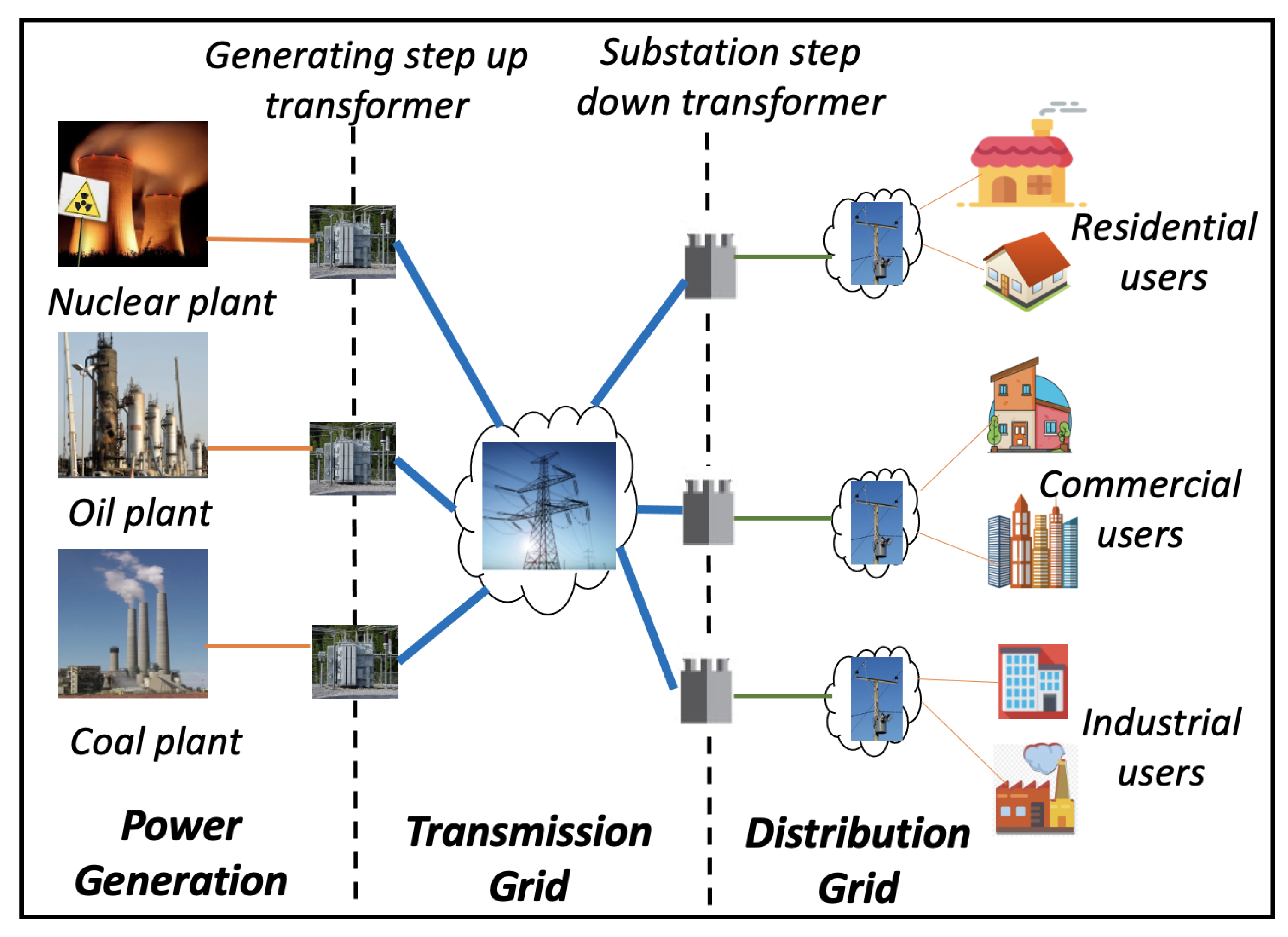
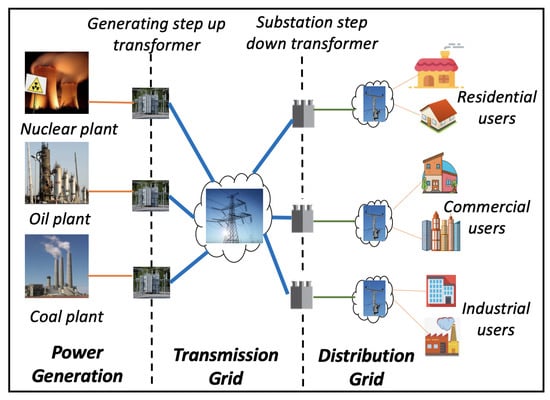
1.2. Blockchain Technology
1.3. Machine Learning
Machine learning will give computers the ability to learn without being explicitly programmed. A better definition for ML was given by Tom M. Mitchell as “a computer program is said to learn from experience E with respect to some class of tasks T and some performance measure P, if its performance on T, as measured by P, improves with experience E” [11][24]. More clearly, as computers/models are exposed to a set of new data, they will adapt independently and learn from previous patterns to interpret available data and identify hidden patterns. ML adopts techniques from diverse set of disciplines that include philosophy, probability, information theory, statistics, control theory, artificial intelligence and so on [12][23]. ML algorithms are being used in various applications domains, such as financial services, marketing and sales, government, healthcare, transportation, and so on. ML techniques can be generally classified into four categories: (1) supervised learning; (2) unsupervised learning; (3) semi-supervised learning; and (4) reinforcement learning. Figure 28 classifies different ML techniques.
2. Blockchain in Smart Grids
The use of BC technology in the energy sector is a key research topic nowadays. As the energy industry is undergoing tremendous transformations with the adoption of ICT, it has become a prominent research area. Intelligent grid implementation with minimal power loss, high power quality, reliability and security are the main goals to be attained.
The distributed architecture of SG is depicted in Figure 34. However, maintaining all these distributed functionalities by a single centralized server is complex and highly vulnerable [13][6]. The ultimate aim of all the transformations in the grid is to reform the existing energy industry by bringing producers and consumers closer to each other using distributed generation and resources. In centralized systems, all the users, energy operators and market system interactions are dependent on central entities. These intermediaries can monitor, control and support all activities within the elements in the grid [14][18]. Additionally, the long-distance transmission network is opted to deliver energy to end users through distribution stations. The increase in the number of elements associated with the grid raises some concerns [15][27], which include scalability, reliability, availability, communication overhead and so on. All of these issues point toward the need for a decentralized structure for energy grids to create a more dynamic and flexible grid structure [16][50].
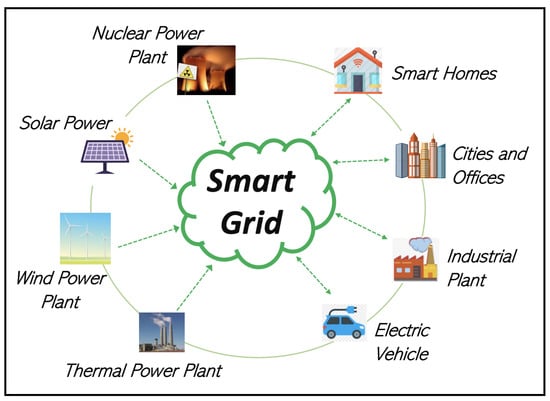
Security, energy management, EV charging and energy trading are also some of the areas to be transformed and implemented effectively. As users are becoming prosumers through distributed generation, they can trade electrical energy to other grid users. Traditional methods fail to provide a secure and flexible energy trading platform [17][44] where users can trust each other. Due to privacy and security concerns, most of the users show less interest in participating in energy trading. Hence, a decentralized platform which can create a trust environment for secure energy trading is required. Indeed, the penetration of EVs also has effects, as energy trading between EVs can also be done [18][62].
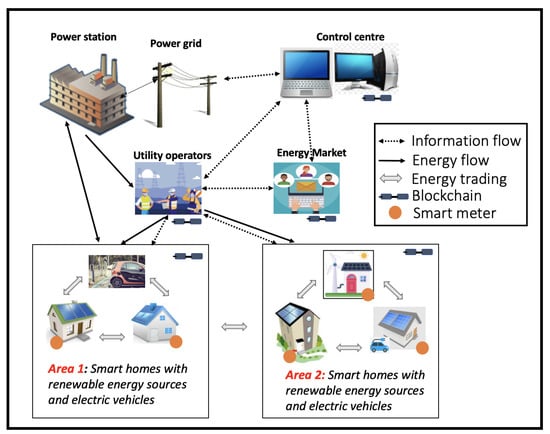
2.1. Energy Trading
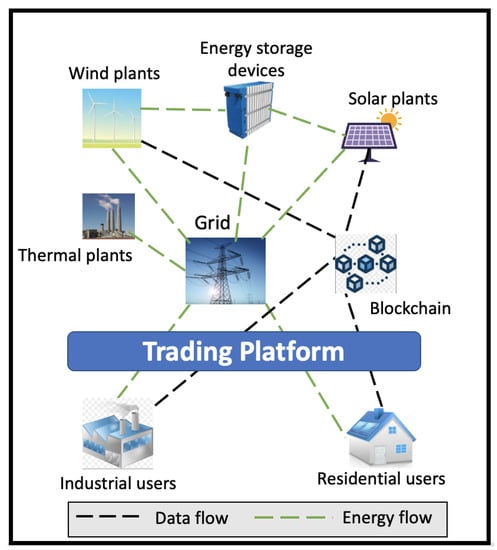
2.2. Electric Vehicles
EVs play a significant role in the smart grid infrastructure and they also solve some of the environmental problems by facilitating green travel. However, EV users are facing challenge in charging, as the number of EVs are increasing while the number of available charging stations are decreased. Additionally, short communication ranges, the need for frequent communications and mobility of EVs add new security and privacy concerns [25][84]. On the other hand, the high penetration of EVs and less-coordinated charging schedules might lead to overloading in the grid. Hence, there in an open challenge to integrate all these EVs in the grid, schedule the charging operations effectively and develop a transparent and secure charging system. Many researchers adopt decentralized BC technology to solve these issues and enhance the use of EVs and its charging management [18][26][27][28][29][30][31][32][62,85,86,87,88,89,90,91].2.3. Demand Response Management
Several research works explore different techniques to develop an innovative DRM system with the adoption of BC technology. The main idea of most of the works was to develop a secure trading platform for distributed prosumers and EVs. Smart contracts which can execute upon reaching desired conditions gained great acceptance in the DR application [33][34][35][36][37][38][39][40][92,93,94,95,96,97,98,99]. Some of the works which aims to develop better DR prototypes are listed in Table 17.
4. Integration of Blockchain and Machine Learning for Smart Grids
Combining BC and ML for various applications is increasing. The learning capabilities of machine learning can be applied with blockchain to make the chain smarter [47][105]. Additionally, the computational power for ML models can minimize the time taken for the nonce calculation. On the other hand, using the decentralized data architecture of blockchain, better ML models can be built. The main benefits of combining BC and ML are (a) security, (b) improving energy consumption, (c) improving the smart contracts, (d) data trading and more. BC is a continuously growing data ledger, whereas ML requires large volumes of data. Both techniques complement each other and have high potential when combined for different applications. With the decentralized and immutable structure, BC builds a trust environment without third parties for any transactions occurring. ML-based solutions mainly help in demand management using prediction techniques and help in handling large amount of data from smart meters [48][33]. Additionally, optimization techniques can be used for scheduling the energy usage of users. Applying BC into ML systems helps such systems to use information collected by BCs to clear problems quickly, and applying ML techniques to BC adds powerful intelligence to BC systems for data processing and other intensive applications [11][24]. The storing of large-scale data in a secure and tamper-proof manner by BC-based systems ensures the confidentiality and auditability of the collaborative data training process and trained model using cryptographic techniques. Additionally, it enables decentralization that ensure access control with central authorities. Smart contracts and Dapps allow to model interactions between entities in the decentralized ML application. In the same way, adding ML helps the BC system to achieve energy efficiency, scalability, security and intelligent smart contracts. As ML can predict and speedily calculate data, it provides a feasible way for miners in selecting important transactions. Using predictive analysis can ensure energy and resource requirements to be met and improve overall efficiency. Hence, considering the future SG scenario, both BC and ML can together solve the issues regarding energy trading, EV charging and scheduling, load prediction, DRM, security and privacy concerns. Table 29 summarizes the existing works that combine BC, ML and SGs.| Ref | Major Contribution | Technical Resources | |
|---|---|---|---|
| [49] | [25] | Evaluate the development of a decentralized EV charging infrastructure using BC, AI and SGs | - |
| [50] | [106] | Proposes a decentralized electricity trading framework (DETF) for connected EVs. | Hyperledger, smart contracts, predictive bidding |
| [51] | [107] | Proposes DeepCoin, a BC and DL based framework to protect SGs from cyber attacks. | Recurrent neural networks, Hyperledger, PBFT |
| [52] | [108] | Explains P2P trading system for sustainable power supply in SGs using BC and ML | Hyperledger, smart contract, PBFT, Predictive model using LSTM |
| [53] | [109] | Explains an intelligent EV charging system for new energy companies using consortium BC | Smart contracts, Limited Neighborhood Search with Memory (LNSM) algorithm |
| [54] | [110] | Proposes an energy trading approach using machine learning and blockchain technology | Smart contracts K-nearest neighbor |
| Ref | Major Contribution | Technologies Used | |
| [27] | [86] | Proposes an EV charging scheme in a BC-enabled SG system which minimizes power fluctuation level in grids and charging cost for EV users (AdBev scheme) | Ethereum, smart contracts |
| [33] | [92] | Investigate use of BC mechanism in demand management by setting up decentralized P2P energy flexible marketplace | Smart contracts |
| [34] | [93] | Design a BC based secure energy trading framework (SETS), having security and privacy preservation to manage demand response management (DRM) | Ethereum, smart contracts, Etcoins |
| [35] | [94] | Explains an algorithm for secure DRM in SGs using BC that helps to take efficient energy trading decisions for managing overall grid load | Energy coins, PoW |
| [36] | [95] | Proposes a secure model for energy trading using BC, contract based incentive mechanism for load balancing and route optimization algorithm to reduce EV traveling time. | Consortium BC, Proof of Work based on Reputation (PoWR), shortest route algorithm |
| [37] | [96] | Proposes a decentralized cooperative DR framework to manage the daily energy exchanges within a community of Smart Buildings and allows participants to decide on day-ahead community power profile, subsequently ensures the forecast tracking during the next day. | Ethereum, smart contracts |
| [38] | [97] | Proposes an energy scheduling scheme among multiple microgrids, EV energy scheduling integrated with microgrid operation and introduces a contribution index to prosumers and whole microgrids for prioritizing in auction. | Smart contracts |
| [39] | [98] | Introduces a BC-based transactive energy(TE) auction model with incorporated DR techniques for increasing social welfare. | Smart contracts |
| [40] | [99] | Addresses the sustainable microgrid design problem by leveraging BC technology to provide the real time-based demand response programs. | Smart contracts |
| [41] | [100] | Proposes an optimal power flow based DRM system without any central authority | Smart contracts |
